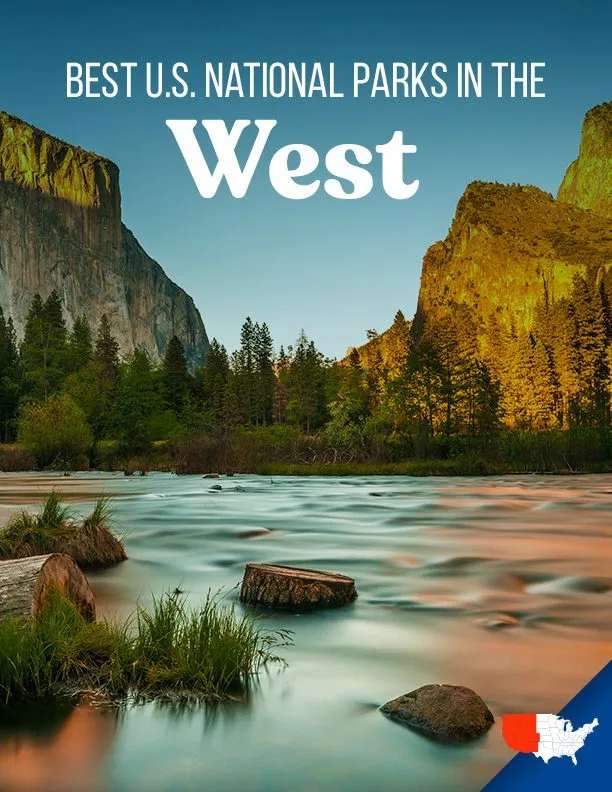Best U.S. National Parks in the Northeast
Best U.S. National Parks in the Northeast
We are privately owned and not affiliated with the government in any way or form.

Introduction
When you think about the Northeastern United States, you may think of the birthplace of a nation. Important historical monuments and sites are abundant in this region – from the Statue of Liberty in New York to the Liberty Bell in Pennsylvania. The Northeast is divided into two divisions: New England, made up of Connecticut, Massachusetts, Rhode Island, New Hampshire, Maine and Vermont, and the Mid-Atlantic region, home to New Jersey, New York and Pennsylvania. The Pilgrims first landed in what is now known as Massachusetts but all nine states that make up the New England division were among the 13 original colonies that joined the U.S. upon its independence in 1776.
Beyond its historical importance, this area of the United States is also one of the most culturally diverse and densely populated regions, boasting the largest city in the country, our beloved Big Apple – New York City. The Northeast holds Cape Cod’s beautiful beaches and one of the world’s most incredible natural wonders, Niagara Falls. Also the richest region in the U.S., it includes many of the country’s wealthiest states and is a treasure trove of some of the most memorable and recognizable national parks, breathtaking landscapes and plenty of must-see natural and historical attractions. Read on for our take on the national parks you definitely don’t want to miss during your next visit to the Northeast.
New England Division
Boston National Historical Park
Massachusetts

If you are looking for an educational twist on the typical national park experience, Boston’s 43-acre historical park won’t disappoint. This park covers many different areas of the city including memorable sites, historic homes and meaningful monuments. Boston was one of the most influential cities in the founding of the United States so it makes perfect sense that the Boston National Historic Park showcases the city’s importance and preserves some of its most precious landmarks. The park operates two different visitor centers: one in the Charlestown Navy Yard and the other in Faneuil Hall. Visit either one to collect maps, information and secure a free ticket for a ranger-led scheduled tour.
Consider taking the “Cradle of Liberty” guided tour in Faneuil Hall to learn about the Hall’s past significance and its continued importance today. Located near the waterfront in Government Center, Faneuil Hall has been a marketplace and meeting hall since 1743 and remains one of Boston’s most popular tourist sites today. It played host to some of the most impassioned speeches, lectures and debates as early colonists made decisions that would help develop a nation. Even now, it still serves as a hub for political and social discourse.
The Freedom Trail and Black Heritage Trail, also National Historic Landmarks, share many sites with Boston National Park which means that visitors can enjoy learning the rich history from different times and peoples, while in the same locations. Another great stop along the way is the Charlestown Navy Yard which has built, maintained and supplied ships for over 170 years. This site remains an active Navy base today. You can enjoy the Navy Yard any time of the year as it is open all year long. Climb aboard its most popular feature, the USS Constitution, an undefeated sailing frigate, a truly beautiful ship to behold. Go below deck to see what life is like on a military vessel.
There are no entrance fees at the federally owned historic sites within the park including the USS Constitution and Faneuil Hall. However, admission fees are collected at some of the park’s privately owned partner sites such as the Old North Church. Built in 1723, this was the location where Paul Revere famously lit the signal lanterns at the start of the revolutionary war. Bring the family to spend the day at the park or travel solo if you wish to brush up on your history knowledge. There are countless stories to hear and tidbits to learn but don’t be afraid to explore outside of the pre-set paths, too.
Boston is also home to the Boston African American National Historic Site, the John F. Kennedy National Historic Site (JFK’s birthplace), and the Cape Cod National Seashore, among many others. While Boston is beautiful any time of the year, May and June offer fragrant, bursting cherry blossoms that fill the city with the perfume of spring. When planning your trip, please note that many of the sites are closed on Mondays or both Mondays and Tuesdays. Here is a list of hours:
- Faneuil Hall Visitor Center
- Monday and Tuesday: Closed
- Wednesday – Sunday: 11:00 AM – 4:00 PM
- Faneuil Hall, Great Hall
- Monday and Tuesday: Closed
- Wednesday – Sunday: 11:00 AM – 4:00 PM
- Charlestown Navy Yard Visitor Center
- Monday: Closed
- Tuesday – Sunday: 10:00 AM – 5:00 PM
- USS Cassin Young
- Monday and Tuesday: Closed
- Wednesday – Sunday: 10:00 AM – 4:30 PM
- Bunker Hill Museum
- Monday and Tuesday: Closed
- Wednesday – Sunday: 10:00 AM – 5:00 PM
- USS Constitution Museum
- Fall and winter (November 1 – March 31)
- Daily 10:00 AM – 5:00 PM
- USS Constitution
- Fall and winter (November 1 – March 31)
- Monday and Tuesday: Closed
- Wednesday – Sunday: 10:00 AM – 4:00 PM
- Paul Revere House
- Daily 10:00 AM – 5:00 PM
- Bunker Hill Monument and Lodge
- Closed
New England National Scenic Trail
Connecticut and Massachusetts
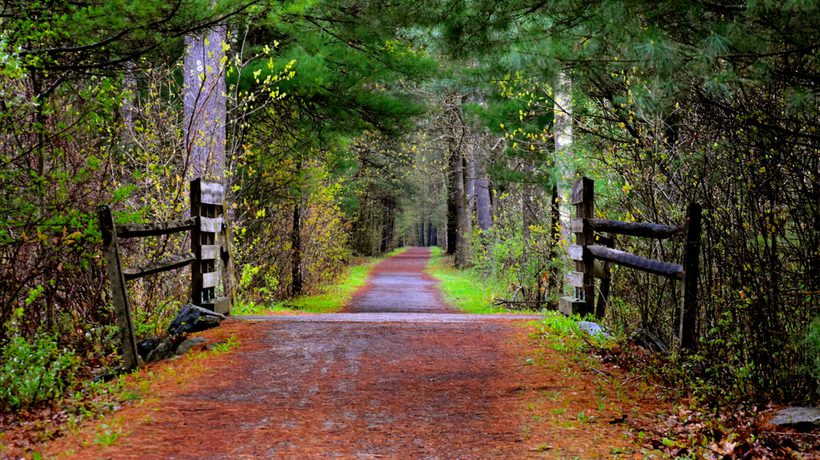
The New England Trail, also referred to as the NET, covers 215 miles of scenic landscapes and houses the so-called Triple-M trails of the Metacomet-Monadnock-Mattabesett trail system. Providing views of stunning mountain peaks and the windy shores of Long Island Sound, the NET stretches through both Connecticut and Massachusetts. Because it is a contiguous trail, it is possible for the seasoned hiker to make the trek in its entirety, starting at a magnificent 17th-century stone house in historic Guilford, CT all the way to the Massachusetts/New Hampshire border.
The NET was established over half a century ago, and is the perfect place to explore the natural charms that New England offers. It features a range of ecosystems, from mountains to forested glades, to wetlands and traprock ridges. Large river valleys, streams and waterfalls offer peaceful solitude while the long-distance vistas feature panoramic views of the surrounding area. The area is rich in wildlife including deer, coyote, beaver, muskrat, skunks, rabbits and over 400 species of birds. Be on the lookout for two species of venomous snakes, the copperhead and timber rattlesnake, as well as black bears and bobcats.
While serious hikers may be brave and experienced enough to consider hiking the entirety of the NET’s vast expanse, there are more reasonable options that still allow the casual hiker or outdoor enthusiast to see some unforgettable views. Suggested hikes include loop trails and specific sections of the NET trail appropriate for any level of hiker. The Royalston Falls hike features a plunging waterfall and a high rocky gorge that makes for some priceless photo ops. At 1.6 miles long, it can be completed in under one hour, making it a great hiking option for casual hikers or families looking to spend a day enjoying the great outdoors.
Another suggested trail is the 7-mile Mount Lincoln hike, which directs trekkers along the banks of sparkling streams to the peak of Mt. Lincoln, a summit of 1,240 feet. The NET also offers options for overnight camping, though they are limited and therefore require some advanced planning and preparation. Visit the park’s dedicated website to learn about the overnight cabins and campsites available if you wish to enjoy an extended stay. Keep in mind that much of the trail is on private property so setting up camp is restricted to certain areas.
Visiting the New England Trail at any time of year is sure to be beautiful, but the best times are fall and spring. Hiking NET during winter is discouraged due to the possibility of heavy snowfall and a severe drop in temperatures. Fall promises the notable turning of the leaves, in all its gorgeous and colorful glory and moderate temperatures. A close second to fall is visiting during the springtime since the landscape is covered in wildflowers and brimming with migratory songbirds, making it excellent for birdwatching enthusiasts. Summers in New England can often be hot and humid and ticks are common, something to keep in mind when considering camping.
There are two spots where the trail crosses a river but there is no bridge. The first one is at Mile 131.8 and requires you to talk around or shuttle (there are Ubers that are usually available here). The other one is at Mile 112.7 and hikers typically ford this river since it is fairly shallow, between knee and waist high. If you feel uncomfortable doing so, you can shuttle around it. The level of hiking difficulty and the amount of time you wish to spend at the park depends on what you’re looking for – a relaxing stroll beside a waterfall, an invigorating climb, a day-long visit or setting up camp for an extended stay? With such a diverse landscape, the choice is yours.
Acadia National Park
Maine
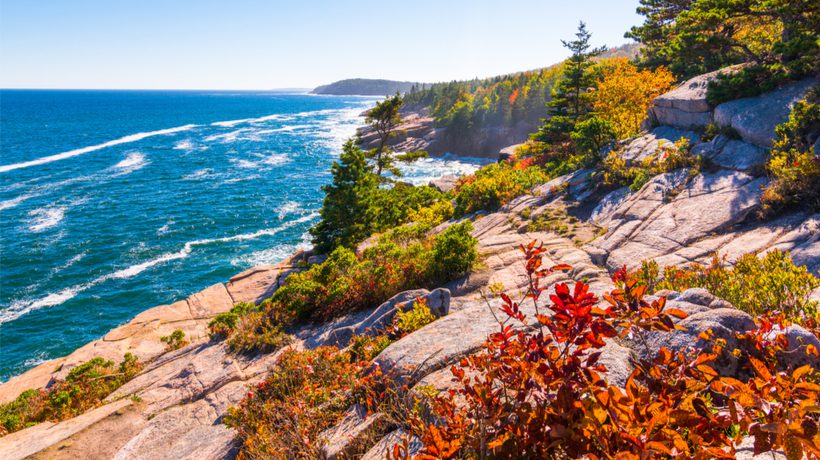
Acadia, located on Mount Desert Island along the Maine coast, is called the “Crown Jewel of the North Atlantic Coast” and with good reason. Located on Mount Desert Island along the stunning coast of Maine, this park has it all! From the rocky ridges along the coastline to over 100 miles of hiking trails, Acadia provides an abundance of natural beauty and diverse natural habitats to explore. Over 3.5 million visitors come to Acadia each year, many of them flocking to Cadillac Mountain, which is just one of seven peaks towering above 1,000 feet in the park. Offering a spectacular view, the summit of Cadillac Mountain is a popular spot for summertime tourists to catch the sunrise or sunset. The 3.5-mile drive to its peak has designated areas where you can pull your car over and take in the spectacular scenery.
Acadia National park offers a variety of exciting outdoor activities. Choose from four different campground areas to use as your home base and then take your pick of kayaking, canoeing, hiking and guided tours. Free shuttle service is provided from mid-April through November. Acadia boasts 45 miles of carriage trails and 16 stone bridges, built by John D. Rockefeller in the early 1900s. These crushed stone roads are made from granite quarried in the area. Many visitors rent bicycles in nearby towns and bike along the carriage roads. If biking the Park Loop Road, do so with caution since there is no shoulder.
Acadia is a wonderful park to visit any time of the year; in fact, they even offer winter activities such as cross-country skiing and snowshoeing. Hiking in winter is not recommended, since the area gets about 60 inches of snow and conditions can be hazardous. If you want to catch the colorful fall leaves, the best time is usually mid-October. We highly recommend you bring your camera to capture the motley of deep red, yellow and brown hues of the turning foliage. The temperature here is more moderate than that of inland Maine and there is an abundance of precipitation, including rain, ice storms and summer fog, so come prepared.
Two sandy beaches offer freshwater and saltwater, perfect for a sunset canoe trip or taking a refreshing dip during the warmer months. Between May and October park rangers offer hikes, boat cruises, tours and various children’s programs. Acadia’s wild abundance provides shelter to all sorts of seasonal wildlife, like puffins, sea ducks, migrating birds of prey, peregrine falcons, hawks and spring warblers. Local birdwatching tours are definitely worth looking into if you’re interested in learning more about this region’s feathered residents. Speaking of which, feel free to bring along your own furry friends, as leashed dogs are welcome in the majority of the park, including most hiking trails.
With so much to do, it is little wonder that the average visit to Acadia is 3-4 days long. The expansive, starry night skies are perfect to pitch your tent under. Weekly passes are $30 per vehicle and can be purchased upon arrival to the park or online. However, if you plan on camping overnight within the park’s grounds, it is suggested that you make reservations in advance. For the sensitive-skinned, keep in mind that black flies tend to be active in the area from mid-May to mid-June – and yes, they bite.
The more popular of the park’s landmarks, like Cadillac Mountain, draw large crowds during the busier hours of the day (10-2 p.m.). Avoid the rush by sneaking away to the quieter west side of the island, where you can enjoy lush forests and a more serene atmosphere.
Appalachian National Scenic Trail
Maine to Georgia

Calling all serious outdoor enthusiasts and hikers– this one is for you! What list would be complete without mention of the famed Appalachian Trail? More than 2,190 miles of Appalachian Mountain ridgelines from Maine all the way through to Georgia, this is one of the most famous trails in the United States. The trail traverses many different forests and parks with varied changes in elevation and countless ridges and peaks, making it one of the most biodiverse members of the National Park System. Along the trail you’ll find an abundance of wildlife such as wild pigs, bears, raccoons, snakes, birds, spiders, deer, turkeys and chipmunks. See if you can spot them all along your way. The Appalachian Trail is open year-round and does not cost anything to access. There are numerous access points throughout the many states it spans, so consider finding the one closest to you. Or perhaps you are one of the few brave enough to take up the challenge and hike the trail from start to finish.
Campfires are prohibited and camping is only allowed at designated sites. In Massachusetts, bus service is available from town to town along Route 7, paralleling the Appalachian Trail. The part of the Appalachian Trail that is the lowest and flattest is the thirteen miles that goes through Cumberland Valley, Pennsylvania. This part is the most accessible portions of the trail.
Since hiking the trail can be a relatively solitary undertaking, there are some trail traditions that have arisen and are associated with certain locations. One is at Pine Grove Furnace in Pennsylvania and it is a challenge to eat a half gallon of ice cream in 30 minutes or less. The West Virginia challenge is to listen to John Denver’s song “Take Me Home, Country Roads” the entire time you hike the trail in West Virginia (this typically takes about three hours). Another tradition is that everyone who hikes the Appalachian Trail takes on a trail name, usually based on some experience that happened during the hike.
While more than two-million have trekked a portion, only about 12,000 people have hiked the full length of the trail since its completion in 1937. If you’re planning to join this exclusive group, there are a number of things to consider. This challenge is not for the faint of heart, nor is it something you can do on impulse. It will take time and planning to adequately prepare. The trail can be difficult to traverse, due to large areas made up of irregular rocks that are treacherous to navigate as well as patches of slippery mud that are tricky to maneuver over, especially with a heavy pack. The trail covers many different states with varying climates so be prepared for all types of conditions as unexpected weather can pop up quickly.
A serious undertaking, a hike through the entire Appalachian Trail can take about six months. That’s a big commitment! Take necessary precautions for your safety like carrying current trail maps and, most importantly, knowing how to use them. Stay alert and consider hiking with a partner or group, leaving valuables at home and always keeping money and credit cards on your person but well hidden. Make sure someone off the trail knows your travel plans and check in regularly. A cell phone might be helpful in an emergency but keep in mind that you can go for days on the trail without a signal, which is great for disconnecting from the busyness of life but can present a major problem in an emergency situation. You might encounter some so-called Trail Magic along the way or create some of your own by giving out a candy bar or sharing a word of encouragement with a passing hiker. These acts of kindness and goodwill can make hiking the trail an enjoyable, once in a lifetime experience.
Many thru-hikers begin their journey in Georgia and hike north, usually starting towards late March through mid-April. It is best to start in the early spring when traveling north, while southbound hikers will benefit from starting their trek in late May to mid-June. Hunting season along the Appalachian Trail can be tricky to navigate so be sure to consult the large and small game schedule and regulations. The best practice is to “know before you go” to ensure that you remain in the proper jurisdiction. Preparing and packing for your Trail adventure will require some energy, but you can be sure that it will result in an unforgettable experience as you completely immerse yourself amidst these majestic mountains. And if you overcome the numerous challenges of a thru-hike, it will undoubtedly be a monumental personal achievement and make you the most interesting dinner party guest as you share stories of your time on the trail.
Blackstone River Valley
Rhode Island

Recently designated in 2014 by President Obama, Blackstone River Valley National Historical Park is Rhode Island’s only national park. The area includes various historic districts, the Blackstone River State Park, Old Slater Mill and the Blackstone River and Canal. From the old mill to the dazzling river, explore the park at your own pace. Embark on a self-guided tour through some of the historic sites or go paddling down the picturesque Blackstone River waters. Admission is free and the park is open from dawn to dusk so there is plenty of time to take a stroll through the villages, picnic along the riverside or enjoy the bikeway which includes 14 miles of paved bike paths.
Understand why the Blackstone River Valley is known as the “Birthplace of the American Industrial Revolution” with a visit to America’s first water-powered textile mill, the Slater Mill. The river provided the power that began America’s move from the farm to the factory and much of it started at this very mill. A beautiful site sitting amidst pristine grounds, the Slater Mill is now a museum featuring textile machinery, an early colonial home and a functioning water wheel. Much of the old mill technology has been restored for the public to experience as it used to be.
Also consider visiting the Wilbur Kelly House, a transportation museum where you can learn more about how the river and canal played an integral role in the industrial revolution. The museums are open from May to October, definitely the best time of year to maximize your visit. If you aren’t interested in industrial history or museums, no worries – there is still plenty to do at Blackstone, like cycling or kayaking the great outdoors.
Perhaps the best way to experience the regional beauty is to explore the Blackstone waterways themselves. The Blackstone River and Canal features dams, bridges and canal locks. The river meanders over 45 miles through villages, farms, forests and urban landscapes. The water level drops an average of 10 feet per mile, which made it the ideal place for the many water-powered mills. The park has fishing spots and various boat launches for paddlers. While you could easily spend an entire day at the park, a half-day trip is sufficient to give you an idea of the area and enjoy most of the attractions. If you like scheduling out your day, the park website also includes half-day and full-day itineraries to help you prepare your visit.
Nearby, in the Blackstone River Valley National Heritage Corridor, you can visit a number of interesting and quaint New England towns, including Douglas, Massachusetts, where you can visit the E.N. Jenckes Store and Museum and see what a 19th century New England country store was like or Lincoln, Rhode Island, the site of the oldest surviving Quaker meetinghouses and the home of the Great Road, the oldest highway in the state. Mendon, Massachusetts has scenic Lake Nipmuc, an 85-acre glacial kettle hole and Southwick’s Zoo. Visit Millbury, Massachusetts to see the Asa Waters Mansion, a stop on the Underground Railroad or the vibrant city of Providence, Rhode Island.
Saint-Gaudens National Historic Site
New Hampshire

While the state of New Hampshire doesn’t have an official national park, it does have something truly unique: the Saint-Gaudens National Historic Site. Located in Cornish, the site is the former home of acclaimed American sculptor Augustus Saint-Gaudens (1848-1907) who created over 150 works of art, including numerous famous public monuments. His 1907 design for the Twenty Dollar Gold Piece, commissioned by President Theodore Roosevelt, is widely considered to be one of the most beautiful coins ever minted. These rare coins can fetch over $4,000 each today! Saint-Gaudens is widely considered one of the greatest artists of the American Renaissance. His home provides an unadulterated combination of art, history and nature in perfect harmony.
This lesser-known and infrequently visited site is a hidden gem known for its unblemished beauty and solitude. It features many of America’s greatest sculptor’s creations, all accessible in one place. The galleries here include over 100 exhibits of Saint-Gaudens’ work. His house, Aspect, also offers various guided tours allowing participants to learn about his life and his art. Choose from the Special Art Tour, the Sculptural Process or a tour on his famous Civil War Monuments. Bronze casts of Lincoln: The Man and the Shaw Memorial, two of Saint-Gaudens’ most famous pieces, can be seen on the grounds year long. The garden contains a series of outside “rooms” separated by hedges, each of which feature a statue by the famed artist. Guided tours are first come, first served and limited to 12 people at a time. Reservations are not taken.
If the art and sculptures aren’t enough to pique your interest, Saint-Gaudens’ winding woodland trails and over 100 acres of forest will appeal to any nature lover. Spot beavers along the quarter-mile Sycamore Trail, listen to the soothing sounds of the babbling brook or visit the swimming hole by following the Ravine Trail. Lodging and camping are not available in the park but there are many cozy bed & breakfast inns in the nearby towns. If you prefer sleeping under the stars, camping spots are available less than 10 minutes away at the nearest state park.
Park exhibit buildings are usually open May through November and open hours are from 9 a.m. to 4:30 p.m. daily, with the surrounding grounds open until dusk. Your doggy friends are welcome in the outdoor areas but cannot enter the buildings. Avoid visiting during winter, as the park is not maintained in many areas and may be hazardous and slippery. There is a $10 entrance fee for adults 16 years of age and older, which is valid for seven days and can be used for re-entry. Children younger than 15 years of age are free and can take advantage of the Junior Ranger program. If you are looking for family fun, consider the Valley Quest, a rhyming scavenger hunt that leads you through the park to a hidden box at its finish perfect for those with young children. There are Sunday concerts in the studio during July and August, and sculpture classes given by the Sculptor-in-Residence most Saturday afternoons during summertime.
If you have a large party, you may consider visiting on days when the entrance fee is waived, such as Martin Luther King, Jr. Day and Veterans Day. You can also purchase the National Parks America the Beautiful annual, access or senior pass if you plan on visiting frequently or adventuring to more national parks in the future.
Marsh – Billings – Rockefeller National Historical Park
Vermont
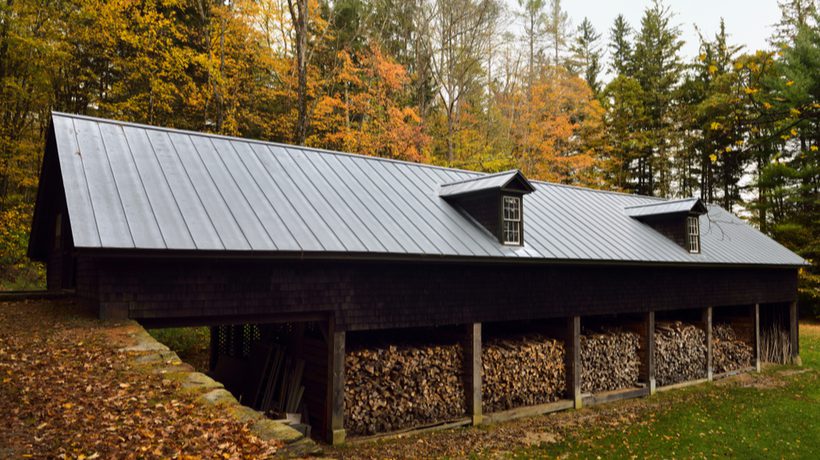
Located in Woodstock, this Vermont park is a must-see if you’re passionate about nature conservation. Known for its untouched beauty and hands-on educational workshops, the Marsh-Billings-Rockefeller National Historical Park offers it all. Woodland enthusiasts will love the informative programs led by park rangers, forestry professionals and scientists covering topics from sawmilling and animal tracking to tree identification and invasive species. You can explore the country’s oldest sustainably managed forest in all its stunning natural wonder and stroll under the shade of 400-year-old hemlocks down winding trails and carriage roads. The 20 miles of trails are open all year but are perfect in the summer, spring and fall for equestrian use and hiking, or for snowshoeing and cross-country skiing in the winter. Experience the picturesque beauty of the Green Mountains and get a taste of the New England charm that makes Woodstock a state treasure.
With over four different tours offered each day, there is plenty to learn and explore in this historical park. History lovers will discover landmarks of the Underground Railroad as well as Vermont’s role in the fight against slavery. Visit the mansion where three prominent conservation families lived and step back in time to see how people lived. Guided tours of the mansion and its pristine grounds and gardens are offered from late May to late October. Check the calendar of events for other special activities like the park’s Trek to Taste, a walking tour where participants can enjoy the fresh air while sampling delicious local foods. Your leashed canine pals are also welcome to hike alongside you through the fields and forests on the property.
There are several buildings on the property including the beautiful Marsh-Billings-Rockefeller mansion, the Belvedere Complex with its bowling alley and fallout shelter, the Forest Center classroom/meeting center and the Asian-themed Bungalow.
Woodstock is truly a four-season destination including the winter, when Marsh-Billings-Rockefeller is transformed into a white wonderland with the area blanketed in an average snowfall of 80 inches. Grab your snowshoes or skis and take to the park’s groomed ski trails (ski passes are required and can be found at the Woodstock Nordic Center) or take to the ungroomed, natural backcountry trails. Be prepared for very cold weather, as winter is the longest season in Vermont with temperatures that vary widely. But don’t let that stop you from taking in vast mountain pastures, frozen ponds and spectacular views of snow-topped valleys and hills.
If winter sounds a bit too chilly for you, summers at the park offer the most in terms of tours, services and programs. The Junior Ranger program for children aged 7-12 will help little learners understand the importance of conserving and caring for these woodlands and our planet. Venture outside the park to stroll the charming pedestrian town, where dogs are welcome in most establishments. Stop by the Plymouth Cheese Factory, the second oldest cheese making operation in the U.S., opened by President Coolidge’s father, and get a taste of their local artisanal cheeses.
Cape Cod National Seashore
Massachusetts

The Cape Cod National Seashore is in eastern Massachusetts, about 90 miles southeast of Boston by car or 55 miles by ferry. It encompasses thirty miles of beaches plus salt marshes, freshwater wetlands and wooded areas for a total area of 40,000 acres. There are two visitor centers: the Salt Pond Visitor Center by the beach, open daily and the Province Lands Visitor Center which is only open May 1 through October 31.
Unlike many other beaches throughout the United States, these sandy shores have no buildings on them and are wide and clean. The beaches all have their own unique flavor, from family-friendly Coast Guard Beach in Chatham to pristine Nauset Light Beach, where you can also visit the famous Nauset Lighthouse in Eastham to Herring Cove Beach near Provincetown where visitors gather to see the stunning sunsets. In addition to the Nauset Lighthouse, there are several other historic lighthouses along the CCNS including the Highland Light in Truro (this is currently undergoing renovation), the Three Sisters Lights in Eastham and the Race Point Light in Provincetown. There are daily beach fees between late June and mid-September, so come prepared with some cash, or you can purchase a national seashore seasonal pass good for the whole summer.
Most of the National Seashore is open to hunting and you can hunt for deer, cottontail rabbit, snowshoe hare, opossum, raccoon, fox, coyote and woodchuck as well as grouse, quail, starline, pheasant, eastern wild turkey and migratory waterfowl. All Massachusetts hunting regulations must be followed. Hunting is prohibited between March 1 and August 31, except for the spring turkey hunt. If fishing is more your speed, you’re in luck because fish are abundant from the shore, especially striped bass. Prime fishing months are May, June, September and October.
The Nauset Trail has a number of ecosystems, including Salt Pond, a “kettle pond” that is home to quahogs, oysters, fish and shorebirds, the Nauset Spit salt marshes, where oceanic fish, shellfish and a variety of shorebirds, wading birds and migratory waterfowl can be found. Further inland in the Cedar Links of Nauset and the Old Farmstead, there are red cedar, black locusts and aromatic bayberry trees where there are deer, song birds, quail, foxes, rabbits and raccoons.
Mid-Atlantic Division
New Jersey Pinelands
New Jersey

The New Jersey Pinelands were the first National Reserve in the country. With over one million acres of forests, rivers, cranberry bogs, farms, historic towns and wetlands, the Pinelands include portions of seven different New Jersey counties. The reserve is accessible through any of the numerous state parks that call the vast expanse home, such as Allaire State Park, Island Beach State Park, Penn State Forest and the Forest Resources Education Center. There are many additional parks and facilities included in the Pinelands area so be sure to do your research to find the spot that is most convenient for you. The Pinelands cover 22 percent of New Jersey’s land area and are made up of both public and privately owned land. The reserve is full of plants and animals, parks and forests, serene rivers, cranberry bogs and miles of blueberry fields, sure to evoke the kind of landscape you’d find in your wildest dreams.
Twelve-thousand acres of pine and oak pygmy forests boast charming trees that don’t grow past 11 feet tall, which can make you feel like a giant. Bogs, swamps and marshes are surrounded by unique vegetation that is native to the area. Over 850 different species of plants live in the Pinelands, including some rare beauties such as the broom crowberry and the curly grass fern. However, be cautious of poisonous plants, insects and ticks that can make you itchy and irritate your skin.
You can’t have the flora without the fauna, and the wildlife here is certainly something to behold. The Pinelands are home to 43 rare animal species that are listed as endangered or threatened. With 299 bird species, 59 reptile and amphibian species, 91 fish species and 39 species of mammals, it is a certainty that you’ll spot much more than just a stray raccoon during your visit. More than forty endangered species such as bald eagles, eastern timber rattlesnakes and bobcats like here, along with many other species of mammals, birds, reptiles, amphibians and fish.
Wildlife survival is contingent upon maintaining and preserving the natural environment of the Pinelands. This region’s ecosystem is shaped by environmental factors such as fire ecology and water chemistry. Underneath the Pinelands lies the Kirkwood-Cohansey aquifer system which is estimated to contain over 17 trillion gallons of pure water. This aquifer is what sustains many of the bogs, marshes and swamps in the area and feeds the streams around it. Be sure to bring your camera to capture some of this area’s beauty: ruby red cranberries and clear, shallow streams.
The Reserve is open year-round and collects no fees in relation to the Pinelands; however, individual parks held within the Pinelands may have entrance fees. It is advised that you check before you visit. If you are there during October, don’t miss the cranberry harvest tour which will show you the actual harvest happening before your eyes and will teach you about the local history and cranberry culture. You can catch the Chatsworth Cranberry Festival the third full weekend in October for a bit of local color and fun. Another fun stop for families is the Popcorn Park Zoo, a sanctuary for rescued animals including over 200 animals and birds such as tigers, monkeys, black bears.
Depending on the park or facility that you visit you can enjoy a wide-range of activities like hiking, biking, swimming, paddling, bird watching, horseback riding, cross country skiing, hunting and fishing. Consider stopping by some of the interesting landmarks like the Historic Village at Allaire, where the past comes to life through reenactments and educational programs. The Pinelands encompass many prime recreational destinations and is conveniently within driving distance from Philadelphia, New York, Baltimore and the Jersey Shore. Drive the Scenic Byway to immerse yourself in natural beauty and visit the historic towns of the Mullica, Maurice and Tuckahoe River corridors and consider staying at one of the charming bed and breakfasts in the area.
Niagara Falls National Heritage Area
New York
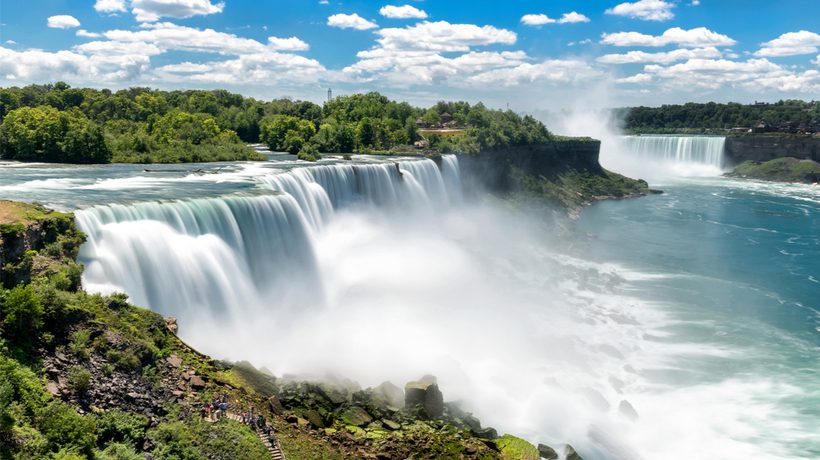
New York has many notable sights to see, but Niagara Falls surpasses them all with its natural wonder and breathtaking beauty. Representing 20 percent of the world’s fresh water, these waterfalls are iconic around the globe. Every year over 8 million people visit the park, the oldest in the United States. Embark on the Maid of the Mist, the famous Niagara boat ride that will take you close enough to feel the mighty waterfall. And don’t forget to visit The Cave of the Winds, where you’ll descend 175 feet into the stunning Niagara Gorge. Staff will prepare you for the power of these awe-inspiring falls with sandals and a poncho, both much needed protection when you’re so close to the thundering Bridal Veil Falls on the Hurricane Deck.
Learn about the rich culture and historic significance of this stunning area. Discover how inventor Nikola Tesla suggested the power of Niagara Falls be best transmitted in regards to his extensive knowledge and use of alternating currents. Visit the new Underground Railroad Heritage Center to explore the significance that the city of Niagara Falls and its surrounding areas held during the Abolition movement. Hear moving stories of abolitionists and freedom seekers. The inspiring and sobering Freedom Crossing Monument on the bank of the river in Lewiston also honors the fugitive slaves who sought their freedom in nearby Canada and those who assisted them.
Though you simply must experience the majesty and the rush of Niagara’s waters firsthand, keep in mind there are many more features to enjoy in this area beyond the waterfall. Park your car and hop on the free Niagara Shuttle to visit 15 destination sites along the scenic Niagara River. Stroll through Whirlpool State Park which sits at the top of the Niagara Gorge. Here you can observe the remarkable whirlpool and hike down the Gorge to observe the turbulent rapids below. If you aren’t ready for the challenge of descending and climbing stairs, you can always travel along a paved trail to get a bird’s eye view of the River. Bring your bike, your pet or your fishing poles. The kids will undoubtedly enjoy the playground, campgrounds, cabins and picnic tables peppered around the grounds. The Niagara Aquarium, featuring over 1,500 aquatic animals, is also a fun detour. Niagara is a great place to bring the whole family and create memories that will last a lifetime.
Because of its favorable weather, the best time to visit Niagara is in the summer; unfortunately, the summertime is also peak season! You are visiting one of the most popular tourist destinations in the U.S. so definitely expect some crowds. One perk of visiting in the summertime is the free Discover Niagara Shuttle which will make it easy to travel to different attractions; all shuttles are equipped with bike racks too.
Hotel rates will be lower in the winter but many attractions, like the boat tours, will be closed. When visiting in the winter, make sure to bundle up since the area is known for low temperatures and plenty of snow. Check out the Cave of the Winds for a frozen winter wonderland experience. Intrepid hikers can join a snowshoe hike through the snow-covered woods.
Another factor to consider is the price. This trip isn’t cheap. Worthwhile add-ons such as a ride on the Maid of the Mist and a visit to the aquarium can quickly add up. Nearby lodging also tends to be pricey. If necessary, prepare by setting a budget and itemizing any expenses you anticipate. Even if you have to pinch pennies to get there it’s well worth it. This extraordinary ecosystem is one-of-a-kind, from the peaceful Niagara River to the awesome power of the Falls.
Saratoga National Historical Park
New York

New York City is a tourism mecca: Times Square, Central Park, The Statue of Liberty and Ellis Island are landmarks that most tourists direct their attention to. But did you know that just a few hours away there is an interesting and less-frequented recreational gem? Saratoga National Historical Park was the site of the turning point in the American War for Independence and, as such, offers tours of the battlefield, the monument and a lush forest trail to explore. In autumn of 1777, British and American forces collided here and the impact of this battle reverberated throughout American history! Considered by historians to be one of the most important battles in world history, American troops battled and defeated the British invasion force. This was the first time in history that the British Army ever surrendered. The battle helped secure U.S. independence, changing and influencing the world as we know it. Fans of war and military history will love exploring the site of this crucial victory of the American Revolution.
Start at the Visitors Center and grab a map and brochure. Saratoga National Historical Park is made up of three sites: Schuyler House, the Saratoga Monument and the battlefield itself. Schuyler House was American General Philip Schuyler’s country home and dates back to 1777. Beautifully restored, join a guided tour of Schuyler House if you can. Climb the steps of the Saratoga Monument, a 155-foot obelisk memorializing the battle where 1,500 British and 800 American soldiers lost their lives and look out over a 30-mile plus vista of natural beauty. Take a self-guided tour of the battlefield with directions from the park brochure or an audio tour that you can access from your mobile device. There’s even an app, so no excuses! If you prefer a guided tour, call ahead for arrangements with an official Saratoga Battlefield Guide for an additional fee.
Walk or bike along the 4.5-mile Wilkinson Trail or take a short drive to Victory Woods where you will find many miles of walkable forest and trails. Perfect for all hiking skill levels, the Wilkinson Trail is surrounded by regional wildflowers during the spring and summer. Victory Woods was the final encampment site of the British Army, before their surrender to the American forces. The Saratoga Visitor Center is open from 9 a.m.-5 p.m. daily, however check before you go since it has been under construction. There are no entrance fees to visit the park. Thanks to Driving Tour Road, available April 1 to Nov. 30, you won’t even need to leave your car to see some of the unique sites this area has to offer. Come spend the day but, as there are no lodging or dining facilities on the property, just remember to bring water and a hearty picnic or sneak off to enjoy some local cuisine nearby.
Delaware Water Gap
Pennsylvania and New Jersey

Once one of the most popular summer resorts in the eastern U.S., thousands of visitors flocked here throughout the 19th and 20th century. Today, the Delaware Water Gap is the perfect place for a rural vacation in the great outdoors. Bike along historic roads or take in the tumbling waters of the spectacular 1,000 foot deep Water Gap from overlook points along PA 611. Seventy-thousand acres of park are covered by forested mountains, hemlock forests, ravines and fertile floodplains. There are also over 100 miles of scenic roadways. You can hike over 100 miles along rolling streams and mountaintops, including 27 miles of the Appalachian Trail. Casual hikers and beginners are welcome, as there is a range of difficulty levels—easy, moderate and hard—with trails clearly marked. During the summer, numerous waterfalls and cascades will cool you off as you soak in this inspiring landscape and take in the lush green forests around you.
Discover the rich history of the valley’s colonial past. The Delaware Water Gap recreation area includes many historic villages and places to explore including 25 sites in the national register of historic places. Where do you start? Perhaps begin at the Visitor Center to pick up a brochure and map before embarking on your outdoor adventure. Take a leisurely ride along Old Mine Road which was constructed in the 1700s to connect the Hudson River and Philadelphia. Some places you might want to visit include Millbrook Village for a taste of the 19th century, the Foster Armstrong House, built in the late 1700s or the Neldon-Roberts Stonehouse, originally built as a school house and displaying items from the 1700s through the early 1900s. Draw inspiration from the landscape, dotted with agricultural fields that have been farmed for over 1,000 years.
Don’t forget to check the park calendar for special events, tours and activities so you don’t miss anything. Delaware Water Gap is wonderful any time of the year. Spring provides flowering trees and wildflowers. Breathe in crisp autumn air and see the colorful leaves turn in the fall. Even winter offers its fair share of beauty with towering, glittering ice walls. But perhaps nothing can beat a dive into the cool river in summertime after a long day of hiking, biking or paddling. Take a relaxing paddle down the river. If you are feeling adventurous, horseback riding and rock climbing are also permitted in the park. Known for offering some of the best and most accessible water recreation in the northeast, this area is ideal for paddlers. Monroe County Transit Authority offers a free shuttle service on summer weekends for those who bring their own kayak or canoe. Don’t have your own boat? No problem! You can rent a life jacket and boat in the park through authorized vendors.
Choose from three beaches (with lifeguards) if you wish to take a dip in the river to cool off. Take a hike and scan the valley from high above on the ridge, peering down into the picturesque Gap below. Bountiful wildlife live in these low forested mountains and the surrounding area; eagles, deer and bears are commonly seen. Hunt for both stocked and native game, or fish the trout streams, which are perfect for angling. Consult the hunting schedule and regulations before visiting.
Independence National Historical Park
Pennsylvania
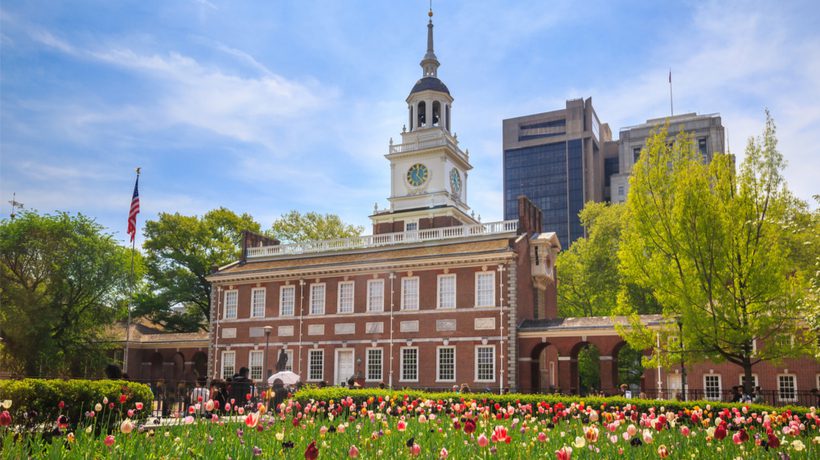
Philadelphia is the birthplace of our nation, the place where the Liberty Bell was first rung and the U.S. Constitution and the Declaration of Independence were debated and signed. Called “The City of Brotherly Love,” this was where people with the early ideas of independence first dreamed of creating a new republic. The National Parks Service has worked to honor and preserve these sites at the Independence National Historical Park. While some parks focus on the great outdoors, Independence is all about museums, artifacts and the incredible stories that formed a nation. If you love history, then this is the place for you.
You can plan your trip by accessing online travel itineraries or simply stop by the Independence Visitor Center to grab a map and a free timed ticket to visit Independence Hall. If you are interested, ask about walking tours and other special events. A trip to Philadelphia would be incomplete without a visit to Independence Hall, where the Declaration of Independence and the Constitution were first conceived and written.
As the temporary capital of the U.S., many of the earliest political establishments and government institutions began here in Philadelphia. Visit the President’s House Site, the home used by George Washington and John Adams during their terms as President. From 1790-1800, the U.S. Congress convened in Congress Hall. Tours in these locations usually take place every half hour during the most popular visiting months, so you won’t have to wait long to delve deeper into the rich history of this city. There are also the Franklin Court Sites, including the Benjamin Franklin Museum and Franklin Court Printing Office, where you can learn more about this prolific scientist, diplomat and entrepreneur. Although in a city setting, there are several lovely gardens to walk through such as the 18th Century Garden, the Rose Garden and the Magnolia Garden. Military enthusiasts can learn about the history of the Continental Army, Navy and Marines in the New Hall Military Museum.
Admission to most of the park sites is completely free. Just don’t forget to secure your free, timed ticket for entry to Independence Hall as it can get very busy! Include an additional nearby stop to observe an international symbol of liberty, the iconic Liberty Bell. This bell’s ring called America’s first lawmakers to political meetings and notified citizens of the news.
The old stories of this area are sure to entertain but, if you are looking for something a bit more modern, Independence Park sits in the center of a sprawling urban area with incredible dining and attractions. Try the regional fare of the famous Philly cheesesteak or hoagie. There are countless options for lodging but if you are looking for an authentic experience, the Thomas Bond House is a restored 18th century home that now operates as a full Bed & Breakfast. Dine nearby at the City Tavern where you can experience 18th century colonial cuisine.
Only a couple of hours away, another site of cultural significance, Gettysburg, awaits.
Gettysburg National Military Park
Pennsylvania

The Union victory at the Battle of Gettysburg was the turning point in the American Civil War and the Civil War’s bloodiest battle. It is also known as the place where one of the most famous political speeches, The Gettysburg Address, was given by Abraham Lincoln in 1863. Start your visit at the Gettysburg National Military Park Museum and Visitor Center where you can pick up a map and a guide book for summer, spring or fall. Plan for a total of four to six hours to do the museum and battleground. You can also get your ticket to see the orientation film, see the cyclorama and enter the museum. The film will give you an excellent overview of the Battle of Gettysburg, while the museum will go more in depth and put the battle in the context of the overall Civil War.
Bus tour fees are $35 per adult and $21 per child age 6-12. Children under six are free. Car tours are more expensive, a car tour for up to six people per vehicle costing $75. There are also ranger programs from September 26 to November 21 including a 90-minute Gettysburg History Hike, 60-minute All Was Confusion: The Battle for Culp’s Hill and the 45-minute tour of Lincoln and the Soldiers’ National Cemetery.
Schedule a personal tour with one of the tour guides, do a bus tour or do a self-guided car tour with the map, with or without a pre-recorded audio tour. The National Cemetery is where the fallen soldiers are buried and where Lincoln gave the Gettysburg Address. You can also visit the David Wills house where Lincoln worked on the Address and stayed while at Gettysburg. There are a range of ranger-led activities in different seasons; these are listed in the guide book. There is food available on-site at the Refreshment Saloon and Battlegrounds Cafe.
For nature lovers, there are 1,600 acres of woodlands and 46 acres of wetland. Animal life is abundant, with red foxes, a variety of birds, turtles and butterflies. Join one of several guided programs during the anniversary of the Battle of Gettysburg around July 1-3. Although the park does not offer horseback rides, there are bridle trails throughout the park and you can rent a horse from a nearby commercial business. If you bring your own horse to the park, there is limited trailer parking available.
When you are finished touring Gettysburg, head over to the nearby Eisenhower National Historic site, where President Dwight D. Eisenhower lived. He used it as a weekend retreat and met with world leaders there.
Statue of Liberty and Ellis Island
New York and New Jersey

No visit to New York City is complete without stopping by the iconic Statue of Liberty and Ellis Island. The Statue of Liberty was a gift from France to the United States in 1886. Since it is on an island, you must take a ferry to access it, which costs between $12.00 for children ages 4-12, $23.50 for adults and $18.00 for seniors. Tickets are also necessary if you want to go inside the pedestal or up to the crown (currently closed), although ranger tours are free.
Aside from Lady Liberty herself, the Statue of Liberty Museum is another fascinating attraction. At 26,000 square feet, the Museum has plenty of space to display duplicates of different parts of the statue (including the original torch) as well as a wealth of interactive exhibits.
And be sure to pay a visit to Ellis Island, the entry point for 62 million immigrants to the United States from 1892 to 1954, mostly from Europe. Today, Ellis Island contains a collection of artifacts that illustrate America’s immigration history throughout our history. Do you have ancestors who entered the US at Ellis Island? Find out at the American Family Immigration History Center.
The monument (Statue of Liberty and Ellis Island) is open daily from 9:30 AM to 4:45 PM. Since you will need to take the ferry, be sure to bring a warm jacket, especially in the winter since it tends to be windy, damp and cold. There is food and a gift shop available on-site.
Thomas Edison National Historical Park
New Jersey
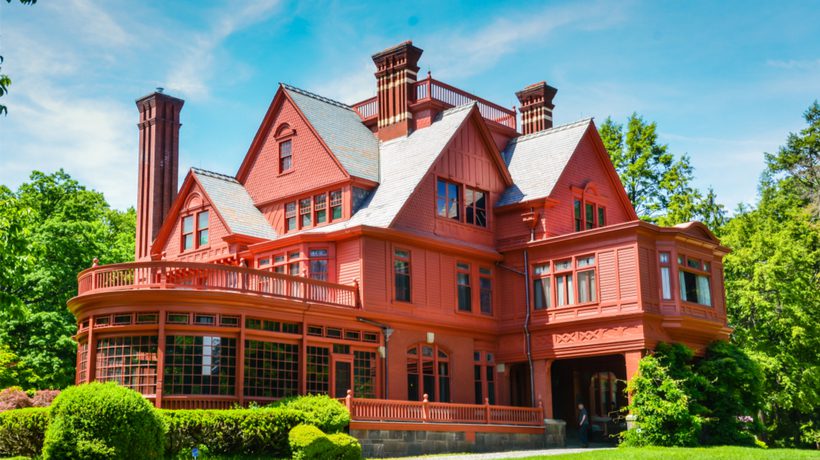
If you love science, then you will love seeing the place where Thomas Edison launched the United States into a new era of innovation. This prolific inventor had 1,093 patents and created the first modern corporate research and development lab. Edison’s innovations include the automatic telegraph, an improvement on telephone technology, making the lightbulb last longer so that it gained widespread use, inventing the phonograph, coming up with the alkaline battery and creating the first movie camera.
Edison lived in West Orange, New Jersey which is less than twenty minutes west of Newark. Start off at the Visitor Center where you can view an orientation film about this extraordinary American and shop the museum store. Then move on to explore the Main Laboratory Building, where Edison’s library, machine shops, music room and other exhibits can be seen. If you’re ready for some greenery, take a stroll through the Glemont Greenhouse, where volunteers care for a variety of exotic plants like those grown by the Edisons. If you are an antique car buff, head over to the Glenmont Garage to see his historic vehicles. Once you get a car pass, you can take a leisurely drive around the grounds and can also listen to the Glenmont Grounds cell phone tour.
Currently, the park is only open Fridays, Saturdays and Sundays from 10:00 AM to 4:00 PM and the Glenmont Mansion and Chemistry Laboratory are closed.



